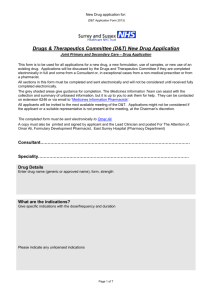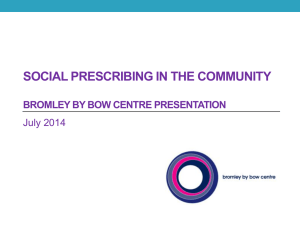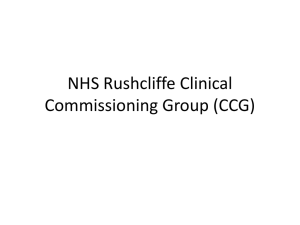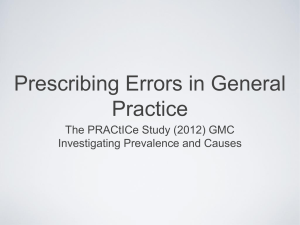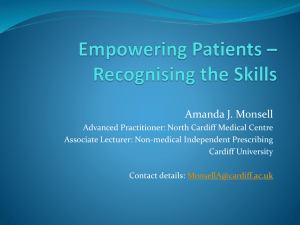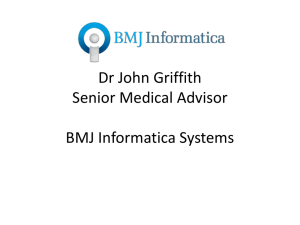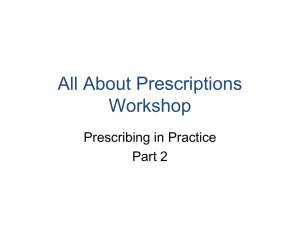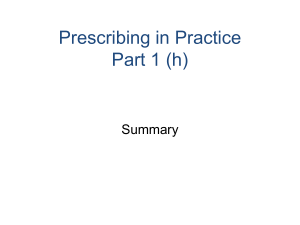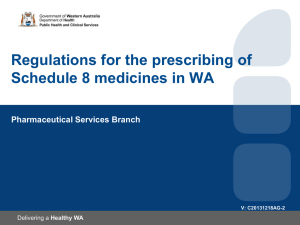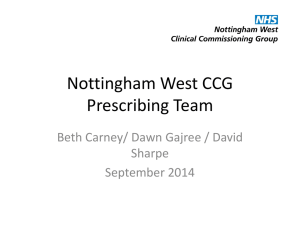Access to medicines
advertisement
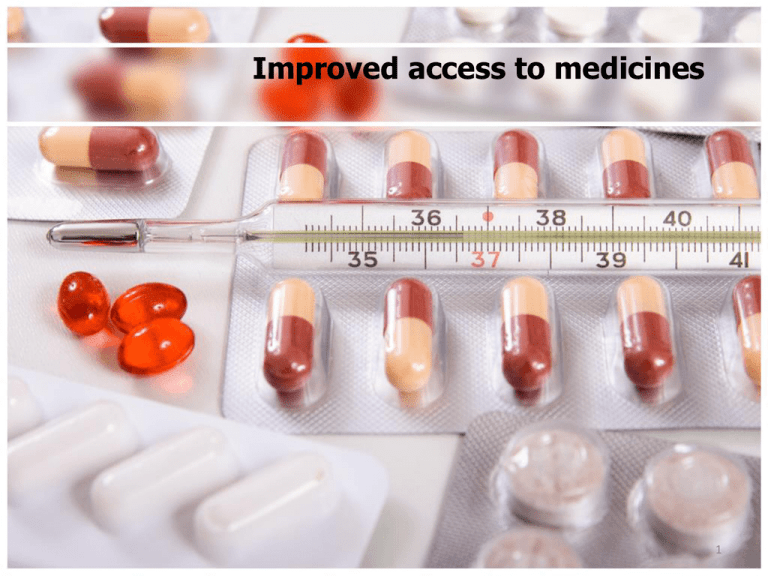
Improved access to medicines 1 Impact of the “Crown Report” • Broadening the public’s access to medicines • Pre-Crown report – Medically qualified doctor prescribed – Pharmacist dispensed medicines – Other prescribers • Nurses • Dentists • Post – Crown report – Patient Group Directions – Non medical prescribing • Independent and Supplementary prescribing 2 Impact of the “Crown Report” • Review Team for the Prescribing, Supply and Administration of Medicines chaired by Dr June Crown 1999 • Independent prescribers – responsible and accountable for the assessment of patients with previously undiagnosed conditions and for the decisions and clinical management required • Supplementary prescribers - a partnership between a medically qualified prescriber and a non-medical prescriber to implement an agreed individual Clinical Management Plans and with the patient’s agreement. • Non-medical prescribers include pharmacists, nurses, optometrists, physiotherapists, podiatrists, radiographers and others being added to the list. 3 Pharmacist Prescribing • Examples of pharmacist prescribing – Anti-retrovirals – COPD and asthma – Antibiotics – Hypertension – Diabetes – Heart failure – Minor ailments/triage in a GP surgery – Pain management – Rheumatology 4 Pharmacist Prescribing • Skills needed – History taking and physical assessment for diagnosis and monitoring – Evidence based prescribing – Public health skills (e.g. cautious use of antibiotics) – Monitoring the impact of medicines – Side effects/adverse reactions/interactions – Communication, consultation and “Medicines Adherence” skills – Red flag symptoms and referral – Legal and ethical aspects of prescribing 5 Pharmacist Prescribing • At the moment – 3 – 9 month postgraduate programme, at least 2 years post-prereg. – Usually inter-professional – Portfolio of competencies – OSCE assessment – Exam assessment – 90 hours learning in practice • In the future – Academic content in undergraduate programme – 90 hours learning in practice, at least 2 years post-prereg – OSCE assessment 6 Aims of non-medical prescribing • To make more effective use of the skills and expertise of groups of professions • To improve patients’ access to treatment and advice • To improve patient choice and convenience • To contribute to more flexible team working across the NHS 7 Patient Group Directions Another outcome from the Crown report: A Patient Group Direction allows specified registered healthcare professionals to supply and / or administer a medicine directly to a patient with an identified clinical condition without him/her necessarily seeing a prescriber. Example of services using a PGD: • An emergency care nurse using a PGD to administer lidocaine to a patient requiring suture of a wound. • A nurse in a sexual health clinic using a PGD to give patients a supply of azithromycin to treat a Chlamydia infection. • A community pharmacist using a PGD to give women the contraceptive pill without a prescription. 8 Patient Group Directions • See handout and use it to answer the following questions • 1. How can a patient’s asthma be managed with the use of supplementary prescribing? • 2. What would be used to permit immediate treatment during an emergency visit to the GP surgery by the patient to see the duty nurse (not the supplementary prescriber) for treatment? • 3. How could a pharmacist independent prescriber contribute to the care of an asthma patient in the surgery? • 4. How could a pharmacist contribute to the care of an asthma patient in the community pharmacy? 9 Case study from NPC – prescribing of antibiotics • Infections are still a major threat to public health • Resistance to antibiotics is inevitable but prudent prescribing helps slow down development of resistance • Antibiotics are not effective in everyone and cause side effects, so in an individual the benefits must be carefully weighed against the risks • Use simple generic antibiotics first whenever possible. Avoid broad spectrum antibiotics (e.g. co-amoxiclav, quinolones and cephalosporins) when narrow spectrum antibiotics remain effective, as they increase risk of Clostridium difficile, MRSA and resistant UTIs • Offering a delayed prescription may be one approach to assist in patient negotiation 10 Case study from NPC – prescribing of antibiotics • An immediate antibiotic prescription and/or further appropriate investigation and/or management should only be offered if the patient: – is systemically unwell or has symptoms and signs suggestive of serious illness and/or complications – is at high risk of serious complications because of pre-existing comorbidity – is older than 65 years with acute cough and two or more of the following criteria, or older than 80 years with acute cough and one or more of the following criteria: – hospitalisation in previous year – type 1 or type 2 diabetes – history of congestive heart failure 11 – current use of oral glucocorticoids Case study from NPC – prescribing of antibiotics • Adults and children over 3 months presenting with the following conditions should be offered a clinical assessment, including a history and, if indicated, an examination to identify relevant clinical signs: – acute otitis media – acute cough/acute bronchitis – acute sore throat – acute rhinosinusitis – common cold • A no antibiotic or a delayed antibiotic prescribing strategy should be agreed for patients with these conditions • Patients’ concerns and expectations should be determined and addressed 12 Case study from NPC – prescribing of antibiotics • If no antibiotics are prescribed, offer: – reassurance that antibiotics are not needed immediately because they are likely to make little difference to symptoms and can have side effects – a clinical review if the condition worsens or becomes prolonged • If a delayed antibiotic strategy is used, offer reassurance and: – advice about using the delayed prescription if symptoms are not starting to settle in accordance with the expected course of illness or if a significant worsening of symptoms occurs – advice about re-consulting if there is a significant worsening of symptoms despite using the delayed prescription – (A delayed prescription with instructions can either be given to the patient or left at an agreed location to be collected at a later date) 13
